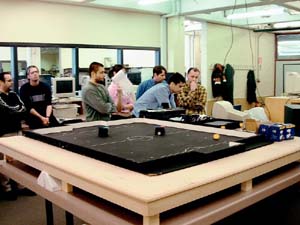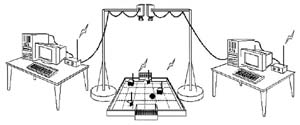| 2004 |

|
YEAR BOOK |
Cork Institute of Technology
|
Robotic soccer
|

Recently, the Department invested in a robotic soccer facility. On a pitch, measuring two metres by one metre, and without any human intervention, two teams of three robots face each other. Box shaped, measuring 8x8x6 cms, with on-board microprocessor and powered by two motorised wheels, each robot defends or attacks as both teams try to hit an orange coloured golf ball into the opposition goal. Overhead, pc-linked high speed cameras feed data to real time software. Coloured markings on the robots help distinguish between teams. Image processing then determines current robot positions, directions and speeds, and those of the golf ball, to decide on the next robot moves. Robot control is via the Bluetooth wireless link. Success hinges on accurate information and software ingenuity.

The Department's Advanced Control Group incorporates specialists in image processing, control theory, mobile communications and digital signal processing. The group is experienced in integrating its strengths to tackle applied problems. It also knows that success in robotic soccer will require the know-how of allied disciplines in physics, mechanics and computer science. Like any team-based sport, success is about individual skill, awareness and intelligence being integrated into a team strategy that is clearly understood by all members. Success in robotic soccer is about success of the technical team.
Contact: Dr Joseph Connell, Advanced Control Group, Department of Electronic Engineering, Cork Institute of Technology;
E-mail: [email protected] ; Web: www.cit.ie